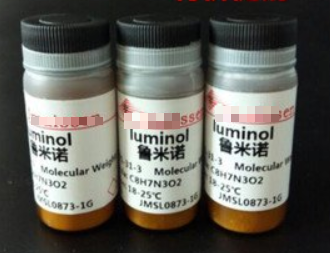Background and overview[1]
3-Nitrophthaloyl hydrazide can be used to prepare luminol reagents. 3-Nitrophthaloyl hydrazide has become the most widely used chemiluminescence reagent due to its high luminescence quantum yield and good water solubility, and can react chemically with a variety of oxidants. Its luminescence mechanism is oxidation reaction luminescence. They are catalyzed by horseradish peroxidase under alkaline conditions and oxidized by hydrogen peroxide to produce an excited state intermediate that returns to aminoterephthalic acid. When it returns to the ground state, it emits Photons. Therefore, luminol reagents have good application value and broad market demand prospects.

Preparation[1]
Into a dry 1000ml three-necked flask, add 100g of dimethyl 3-nitrophthalate, 140g of ethanol, and 83.6g of hydrazine hydrate (50%), stir and heat to reflux, maintain the reflux reaction for 3 hours, and stir to cool down. , cool to room temperature and then filter with suction. The crystals were dissolved with water and filtered. The solution was acidified with concentrated hydrochloric acid to pH 1.5-2, filtered, washed and dried to obtain 60g. The appearance was light yellow crystalline powder 3-nitrophthalic hydrazide, with a yield of 69%. Purity 98.2%, melting point >300℃,
Apply[2]
3-Nitrophthaloyl hydrazide can be used to synthesize luminol. The steps are:
1) Add 260g 3-nitrophthalic acid, 78g urea and 2000ml dimethylformamide to a 5000ml three-necked flask in sequence, heat to reflux (110°C), reflux for 5 hours, and spot plate to confirm 3-nitrophthalic acid The phthalic acid has been completely consumed, and is cooled to room temperature (25°C) to obtain a mixed product A containing 3-nitrophthalimide, which is ready for use;
2) Add 160ml of 80wt% hydrazine hydrate aqueous solution to the three-necked flask, heat to reflux (110°C), reflux for 3 hours, check with a spot plate to confirm that 3-nitrophthalimide has been completely consumed, and cool to room temperature , obtain the mixed product B containing 3-nitrophthaloyl hydrazide, which is ready for use;
3) Add 5g of 10wt% (based on palladium content) palladium carbon into the three-necked flask, stir evenly and then heat to 35°C. Slowly add 260g of 85wt% formic acid aqueous solution while stirring. The dripping time is 2 hours. After the dripping is completed , continue the reaction for 3 hours, confirm by spotting that 3-nitrophthaloyl hydrazide has been completely consumed, adjust the pH to 3-4 with 35wt% concentrated hydrochloric acid, continue to heat to 100°C, filter while hot, and cool the filtrate to 10 ℃, a large amount of precipitation precipitates. After the precipitation is complete, filter the filtrate and recover the organic solvent. The filter cake is washed with 300 ml of deionized water and dried to obtain 182g of luminol (3-aminophthalic acid hydrazide). Yield: 83%, HPLC purity: 99.31%, color: off-white; 1HNMR (400MHz, DMSO-d6): δ11.17 (bs, 2H), 7.42-7.49 (m, 1H ), 7.1-7.5(bs, 2H), 6.36-6.98(m, 2H),
References
[1][Chinese invention] CN200610039015.4 A method of synthesizing 3-nitro or 3-aminophthalic hydrazide
[2]CN201710051577.9 A method of synthesizing luminol or isoluminol using a one-pot method


